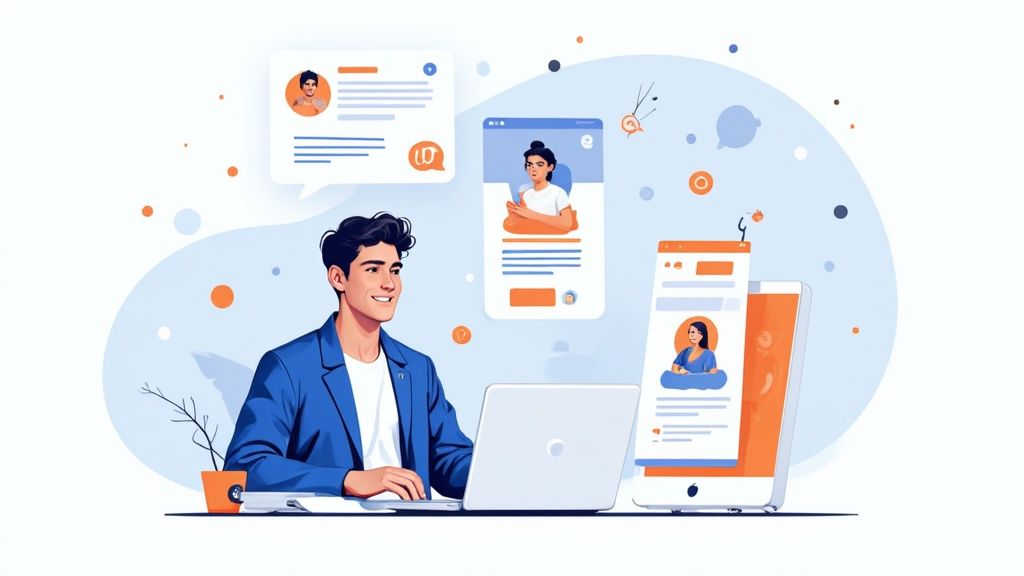Master Your Interview Email Response
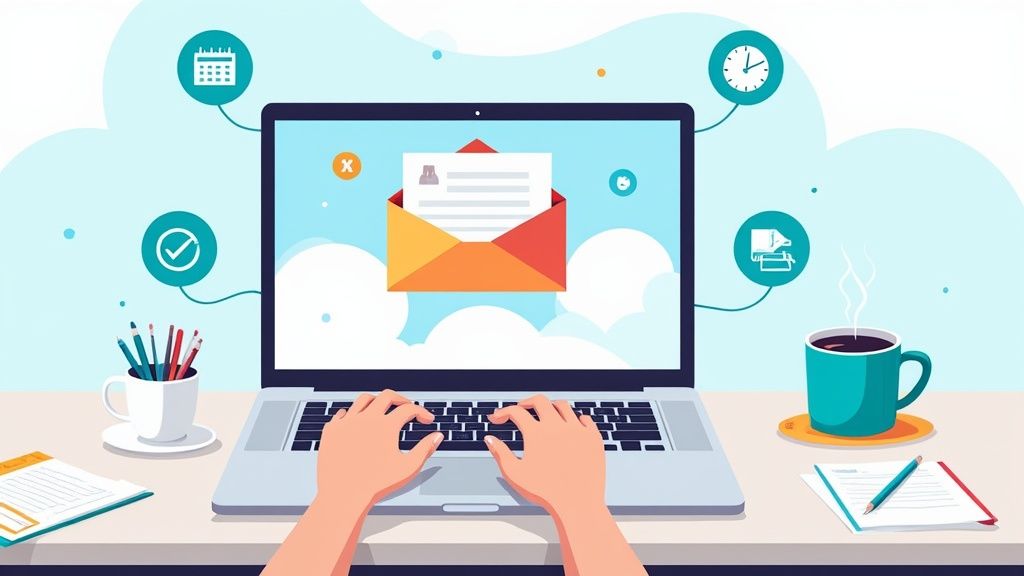
That email pinging in your inbox? It’s more than just an invitation to talk. It's your first real opportunity to make a great impression, often before you even say a word to the hiring manager. Think of it less as a simple confirmation and more as your opening move.
Your reply is a direct reflection of your professionalism, communication skills, and genuine interest in the job. Getting it right sets a positive, confident tone for everything that follows.
Why Your Reply Is Your First Impression
Let’s be honest: that interview invitation is your first test. It’s a subtle but powerful signal of how you handle yourself as a professional. A hiring manager isn’t just looking for you to say "yes." They’re quietly evaluating your communication style, your attention to detail, and how excited you seem about the role.
This is your chance to show you’re a serious candidate who communicates with clarity and purpose. Your response instantly telegraphs a few key things employers are always looking for:
- Professionalism: A well-put-together email with a proper greeting and signature shows you know the basic rules of business communication.
- Enthusiasm: A little genuine excitement goes a long way. It helps you stand out from the crowd of candidates who just send a bland, one-line reply.
- Attention to Detail: Double-checking the job title, date, and time in your reply proves you’re organized and read things carefully. It’s a small thing, but it matters.
The Power of a Positive Candidate Experience
Just as a company's communication shapes your opinion of them, your communication shapes their opinion of you. It's a two-way street. A polished interview response is a key part of creating a positive candidate experience, and that has a real impact.
In fact, research shows that a staggering 66% of candidates accept job offers mainly because they had a good experience during the hiring process. That experience starts with clear, timely communication—like your email reply. On the flip side, poor communication can be a major deal-breaker. You can find more insights about the recruiting process and its stats online.
Your interview email response isn't just an administrative task—it's a strategic move. A thoughtfully crafted reply can subtly influence the interviewer's perception of you before the conversation even begins, building rapport from the very first interaction.
When you get down to it, this first exchange sets the stage. A sloppy, delayed, or overly casual email can raise immediate red flags about how reliable or serious you are. But a polished, prompt, and personal response? That reinforces that you’re the right person for the job and builds anticipation for the interview, giving you a quiet head start.
How to Write a Flawless Confirmation Email
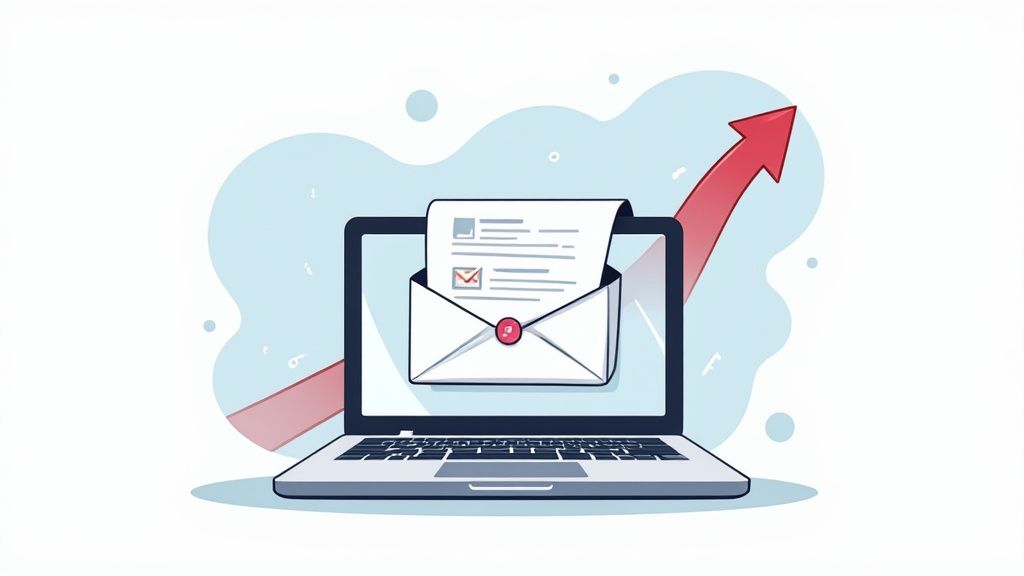
When an interview invitation lands in your inbox, your reply is more than just an RSVP. It’s your first chance to prove you’re organized, professional, and on top of things. The goal here is simple: confirm the details clearly and lock in that positive first impression.
Always, always hit "Reply" to the original invitation. Starting a new email chain is a surefire way to create confusion and get wires crossed. Keeping the conversation in one thread makes life easier for the hiring manager, and that’s a small win you want to take.
Kick things off with a simple, direct thank you. Something like, "Thank you for the invitation to interview," followed immediately by your confirmation of the date and time they proposed. No need to overcomplicate it.
Double-Check and Reiterate the Details
This is where your attention to detail really shines. Don't leave anything to chance—spell out every key piece of information to make sure you and the interviewer are perfectly aligned. This simple step can prevent a world of last-minute stress.
Make sure your confirmation email explicitly lists:
- The Role: Reiterate the exact job title, like "for the Senior Marketing Manager position."
- Date and Time (Including Time Zone): Write it out in full: "Tuesday, October 26th, at 2:00 PM EST." The time zone is crucial, especially for remote interviews.
- The Where and How: Is it a video call on Zoom or Google Meet? A phone call? Or an in-person meeting at their office address? Be specific.
Laying all this out shows you're thorough and leaves zero room for error. It's a small thing, but it signals that you're a candidate who has their act together.
Think of your reply as part of an ongoing conversation. Research on hiring trends and email effectiveness shows that clear, consistent communication is key. In fact, multi-email sequences can boost candidate reply rates to as high as 82%, proving that every message counts.
Show Some Excitement and Sign Off Cleanly
After you've locked down the logistics, add a touch of personality. A brief, genuine line showing your enthusiasm goes a long way. Try something like, "I'm really looking forward to learning more about the role and speaking with the team." It feels authentic and adds a nice human touch.
Wrap it up with a professional closing like "Best regards" or "Sincerely." Follow that with your full name and a clean email signature that includes your phone number and LinkedIn profile URL.
Before you hit send, give it one final read-through. A quick proofread to catch any typos is essential. Just like when you are sending a resume email, this last check ensures you come across as polished and professional from start to finish.
Navigating Reschedules and Declines with Grace
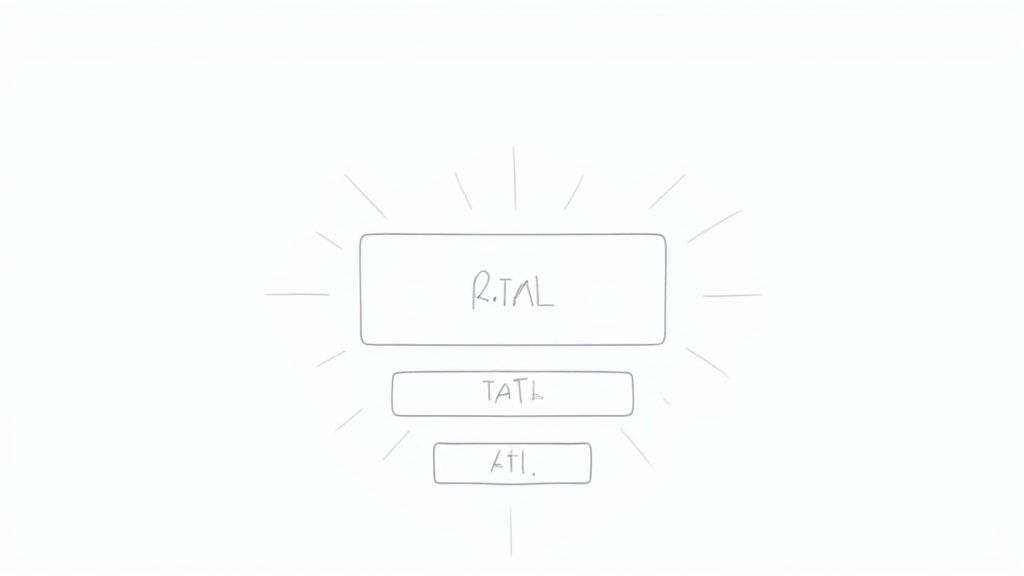
Life happens. A last-minute conflict pops up, or maybe you've had a change of heart about the role. It’s how you handle these moments that truly showcases your professionalism, often more than a simple confirmation ever could.
When you send an interview email response to reschedule or bow out, your mission is to be clear, courteous, and keep your professional reputation intact. Every single email is a chance to leave a positive impression, even if it’s the last one you send.
How to Professionally Reschedule an Interview
If you need to reschedule, speed is your friend. The sooner you reach out, the more you show you respect the interviewer’s time. A prompt request is a sign of consideration.
Don’t just state the problem; offer the solution. Proactively suggesting new times shows you’re still serious about the role and are trying to make the process as smooth as possible for them.
A solid reschedule email should have:
- A brief, polite apology for the change of plans.
- A direct statement that you need to find a new time.
- A few specific alternative dates and times you have free.
This simple structure cuts down on the email tennis and proves you're organized, even when things go sideways.
Withdrawing Your Candidacy Gracefully
Pulling your name from consideration can feel a bit awkward, but trust me, hiring managers appreciate it. It saves everyone a ton of time and lets them move forward with candidates who are fully invested.
The trick is to be direct but gracious. Start by thanking them for the opportunity, then clearly state you're withdrawing your application. There's no need for a long-winded explanation—a simple phrase like "after careful consideration" does the job perfectly. If you want a more detailed walkthrough, our guide on https://aiapply.co/blog/how-to-decline-a-job-interview has you covered.
A candidate’s experience is everything. Research from 2023 shows that candidates who are ultimately hired are the most likely to respond to feedback surveys. This tells us that a positive process, from start to finish, keeps people engaged. Handling a decline with grace is a huge part of that positive experience.
Whether you're rescheduling or declining, a thoughtful, professional email keeps doors open. You never know—that same hiring manager might have the perfect role for you six months from now, and they'll remember the person who handled things with class.
Pro Tips to Make Your Response Stand Out
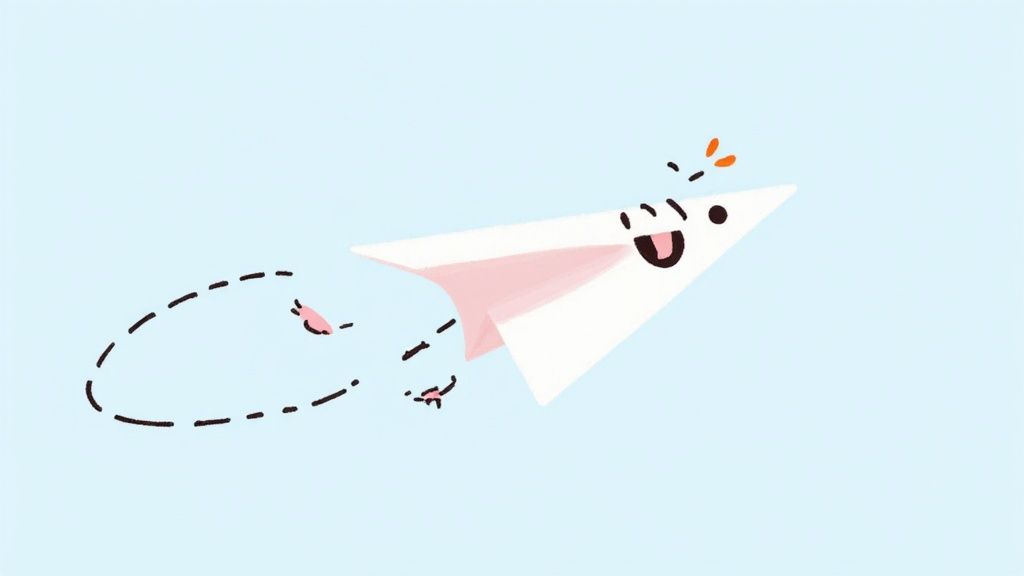
Simply confirming the time and date is table stakes. That’s the bare minimum. If you really want your interview email response to leave a mark and turn a simple confirmation into a powerful first impression, a little thoughtfulness goes a long way.
These small, strategic moves show you're not just another name on a list—you're an engaged, proactive professional who's already thinking about the role.
A great place to start is by mirroring the company's communication style. Did the recruiter start with a formal "Dear [Your Name]" or a more relaxed "Hi [Your Name]?" Matching their tone is a subtle but effective way to show you’re observant and can easily fit into their company culture. A stiff, overly formal reply to a casual email can feel jarring and out of touch.
Another move I always recommend is to ask one smart, concise question. This isn't about giving them homework; it's about showing you're already doing yours. A simple, well-placed question about the role or the team demonstrates that you're genuinely engaged and preparing diligently.
Asking a question signals genuine interest and preparation. It shifts you from a passive recipient to an active participant in the process, a small but powerful psychological distinction.
Perfecting Your Professional Polish
Every single detail in that email contributes to the professional image you're building. Let's be honest, typos and sloppy formatting can send the wrong message, suggesting a lack of care right when you want to appear most attentive.
So, before you hit send, triple-check everything. Read your email out loud—it's a surprisingly effective way to catch awkward phrasing or sneaky typos. This small act of diligence reinforces that you’re a detail-oriented candidate. This same level of care should extend to all your communication, including knowing how to write the best follow-up email after an interview.
Finally, take a look at your email signature. Is it working for you? A clean, professional signature is non-negotiable.
Make sure it includes these key elements:
- Your full name
- A professional title or your field (e.g., "Digital Marketing Specialist")
- Your phone number
- A direct link to your LinkedIn profile
These pieces come together to create a polished, confident impression on the hiring team before you even say hello.
Common Mistakes That Can Cost You the Job
You’ve made it this far, so don't let a simple email mistake sink your chances before you even get to speak with the hiring manager. These little unforced errors can send the wrong message, suggesting a lack of professionalism or attention to detail—and those are serious red flags for any recruiter.
One of the biggest blunders I see is a slow response. In a competitive job market, taking more than 24 hours to reply can easily be mistaken for a lack of interest. You want to show you're eager and engaged, so make it a goal to respond the very same business day you receive the invitation.
Another common pitfall is getting too casual. It’s an email, not a text to a friend. Ditch the slang, emojis, and overly familiar greetings like "Hey." A simple, respectful "Dear [Hiring Manager's Name]" sets the right professional tone from the start.
This image breaks down some of those key differences between a sloppy response and a polished one.
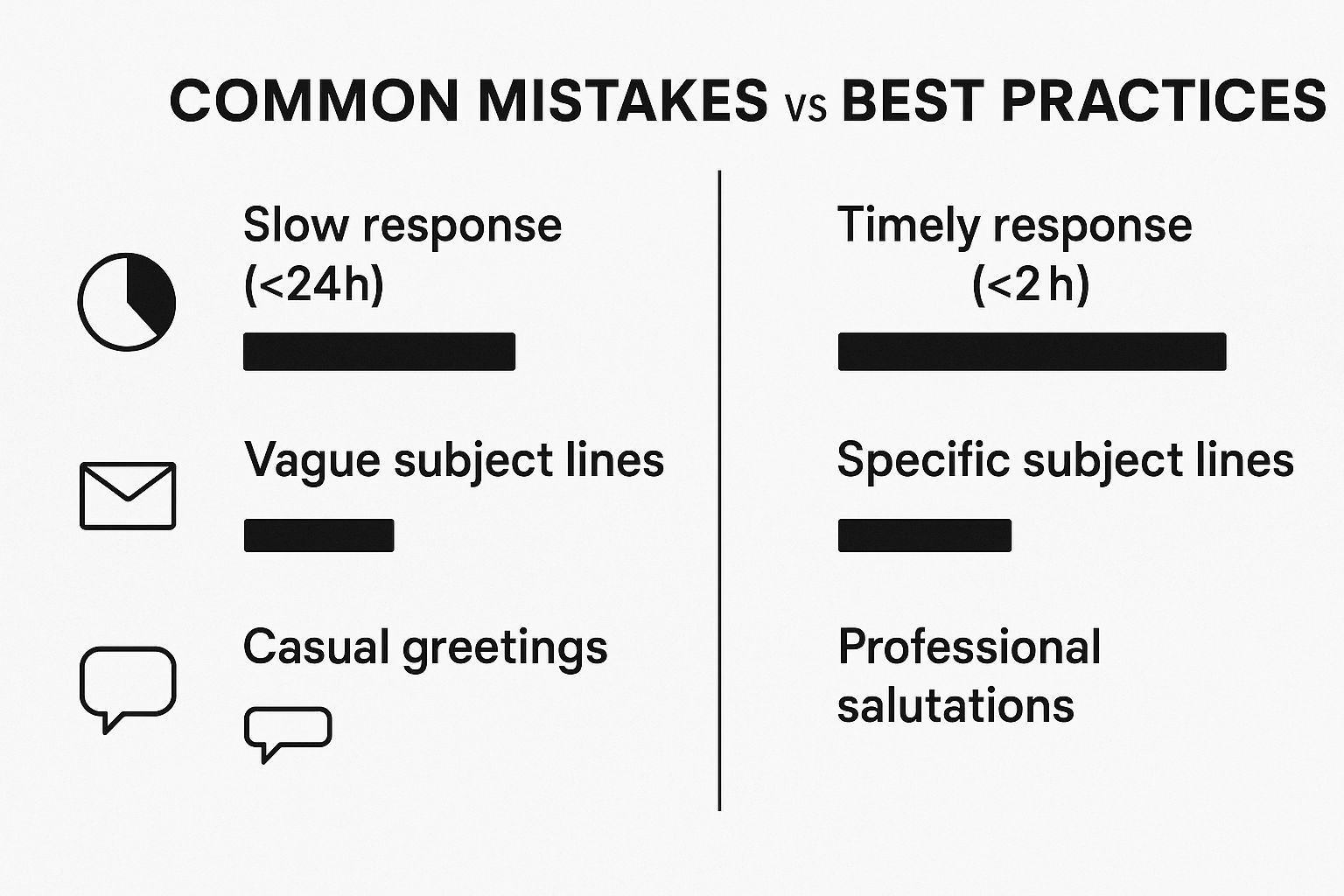
As you can see, small tweaks—like a specific subject line and a professional closing—make a world of difference in how your email is perceived.
The Devil's in the Details: Email Addresses and Typos
Believe it or not, your email address is part of your professional brand. An address like surferdude89@email.com just doesn’t inspire confidence. If you don't have one already, create a clean, simple address for your job search, preferably a straightforward variation of your first and last name.
And finally, the most avoidable error of all: typos and grammatical mistakes. They happen to everyone, but in this context, they scream "careless." They can make it seem like you don't value the opportunity enough to spend an extra minute proofreading your message.
Here's a pro tip I always share: Read your email out loud before you hit send. It sounds a little silly, but it's the best way to catch awkward phrasing and tiny mistakes your eyes might have skipped over.
To help you keep everything straight, here’s a quick-glance table of what to do—and what to avoid.
Interview Email Do's and Don'ts
Nailing the email is just the first step in the process, but getting it right sets a positive tone for everything that follows.
Dodging these common blunders is a huge part of your interview prep. For more in-depth advice on the entire journey, take a look at our complete guide on how to succeed in a job interview.
Your Top Interview Email Questions, Answered
Sending that reply to an interview invitation can feel surprisingly high-stakes. You want to sound professional, eager, and on top of things, but a few nagging questions always seem to pop up. Let's tackle the most common ones so you can hit "send" with total confidence.
How Quickly Should I Respond?
The sweet spot for replying is within 24 hours. This shows you're responsive and excited about the opportunity without coming across as desperate. If you can reply the same business day, that's even better.
That said, don't feel pressured to reply within minutes. Hitting send instantly can sometimes feel a bit robotic. Waiting an hour or two gives the impression that you’ve taken a moment to thoughtfully review the details and check your calendar.
Can I Ask Who Will Be Interviewing Me?
Not only can you ask, you absolutely should. Asking who you’ll be meeting with is a smart, proactive move that signals you're a serious candidate. It shows you’re already preparing.
You don't need to overthink it. A simple line works perfectly:
- "Could you please let me know who I’ll be speaking with during the interview?"
Knowing your interviewers' names and titles ahead of time is a huge advantage. You can look them up on LinkedIn, understand their role in the company, and start thinking about more targeted questions. For more on this, our guide on how to research a company is a great resource.
Pro Tip: This small step transforms the interview from a simple Q&A into a genuine conversation. When you can ask, "John, I saw you led the product launch last quarter, what was the biggest challenge?" you instantly build a stronger connection.
What’s the Best Subject Line to Use?
Keep it simple. Your best bet is to just hit "Reply" on the original email invitation. This keeps the whole exchange in one convenient thread for the recruiter or hiring manager, which they will definitely appreciate.
If you absolutely have to start a new email thread for some reason, make your subject line impossible to miss. Clarity is key.
Something like this is perfect:
"Interview Confirmation: Jane Doe for Senior Marketing Manager Role"
This format is clean, professional, and tells the recipient exactly who you are and what the email is about, ensuring it gets seen and filed correctly in a busy inbox.
That email pinging in your inbox? It’s more than just an invitation to talk. It's your first real opportunity to make a great impression, often before you even say a word to the hiring manager. Think of it less as a simple confirmation and more as your opening move.
Your reply is a direct reflection of your professionalism, communication skills, and genuine interest in the job. Getting it right sets a positive, confident tone for everything that follows.
Why Your Reply Is Your First Impression
Let’s be honest: that interview invitation is your first test. It’s a subtle but powerful signal of how you handle yourself as a professional. A hiring manager isn’t just looking for you to say "yes." They’re quietly evaluating your communication style, your attention to detail, and how excited you seem about the role.
This is your chance to show you’re a serious candidate who communicates with clarity and purpose. Your response instantly telegraphs a few key things employers are always looking for:
- Professionalism: A well-put-together email with a proper greeting and signature shows you know the basic rules of business communication.
- Enthusiasm: A little genuine excitement goes a long way. It helps you stand out from the crowd of candidates who just send a bland, one-line reply.
- Attention to Detail: Double-checking the job title, date, and time in your reply proves you’re organized and read things carefully. It’s a small thing, but it matters.
The Power of a Positive Candidate Experience
Just as a company's communication shapes your opinion of them, your communication shapes their opinion of you. It's a two-way street. A polished interview response is a key part of creating a positive candidate experience, and that has a real impact.
In fact, research shows that a staggering 66% of candidates accept job offers mainly because they had a good experience during the hiring process. That experience starts with clear, timely communication—like your email reply. On the flip side, poor communication can be a major deal-breaker. You can find more insights about the recruiting process and its stats online.
Your interview email response isn't just an administrative task—it's a strategic move. A thoughtfully crafted reply can subtly influence the interviewer's perception of you before the conversation even begins, building rapport from the very first interaction.
When you get down to it, this first exchange sets the stage. A sloppy, delayed, or overly casual email can raise immediate red flags about how reliable or serious you are. But a polished, prompt, and personal response? That reinforces that you’re the right person for the job and builds anticipation for the interview, giving you a quiet head start.
How to Write a Flawless Confirmation Email

When an interview invitation lands in your inbox, your reply is more than just an RSVP. It’s your first chance to prove you’re organized, professional, and on top of things. The goal here is simple: confirm the details clearly and lock in that positive first impression.
Always, always hit "Reply" to the original invitation. Starting a new email chain is a surefire way to create confusion and get wires crossed. Keeping the conversation in one thread makes life easier for the hiring manager, and that’s a small win you want to take.
Kick things off with a simple, direct thank you. Something like, "Thank you for the invitation to interview," followed immediately by your confirmation of the date and time they proposed. No need to overcomplicate it.
Double-Check and Reiterate the Details
This is where your attention to detail really shines. Don't leave anything to chance—spell out every key piece of information to make sure you and the interviewer are perfectly aligned. This simple step can prevent a world of last-minute stress.
Make sure your confirmation email explicitly lists:
- The Role: Reiterate the exact job title, like "for the Senior Marketing Manager position."
- Date and Time (Including Time Zone): Write it out in full: "Tuesday, October 26th, at 2:00 PM EST." The time zone is crucial, especially for remote interviews.
- The Where and How: Is it a video call on Zoom or Google Meet? A phone call? Or an in-person meeting at their office address? Be specific.
Laying all this out shows you're thorough and leaves zero room for error. It's a small thing, but it signals that you're a candidate who has their act together.
Think of your reply as part of an ongoing conversation. Research on hiring trends and email effectiveness shows that clear, consistent communication is key. In fact, multi-email sequences can boost candidate reply rates to as high as 82%, proving that every message counts.
Show Some Excitement and Sign Off Cleanly
After you've locked down the logistics, add a touch of personality. A brief, genuine line showing your enthusiasm goes a long way. Try something like, "I'm really looking forward to learning more about the role and speaking with the team." It feels authentic and adds a nice human touch.
Wrap it up with a professional closing like "Best regards" or "Sincerely." Follow that with your full name and a clean email signature that includes your phone number and LinkedIn profile URL.
Before you hit send, give it one final read-through. A quick proofread to catch any typos is essential. Just like when you are sending a resume email, this last check ensures you come across as polished and professional from start to finish.
Navigating Reschedules and Declines with Grace

Life happens. A last-minute conflict pops up, or maybe you've had a change of heart about the role. It’s how you handle these moments that truly showcases your professionalism, often more than a simple confirmation ever could.
When you send an interview email response to reschedule or bow out, your mission is to be clear, courteous, and keep your professional reputation intact. Every single email is a chance to leave a positive impression, even if it’s the last one you send.
How to Professionally Reschedule an Interview
If you need to reschedule, speed is your friend. The sooner you reach out, the more you show you respect the interviewer’s time. A prompt request is a sign of consideration.
Don’t just state the problem; offer the solution. Proactively suggesting new times shows you’re still serious about the role and are trying to make the process as smooth as possible for them.
A solid reschedule email should have:
- A brief, polite apology for the change of plans.
- A direct statement that you need to find a new time.
- A few specific alternative dates and times you have free.
This simple structure cuts down on the email tennis and proves you're organized, even when things go sideways.
Withdrawing Your Candidacy Gracefully
Pulling your name from consideration can feel a bit awkward, but trust me, hiring managers appreciate it. It saves everyone a ton of time and lets them move forward with candidates who are fully invested.
The trick is to be direct but gracious. Start by thanking them for the opportunity, then clearly state you're withdrawing your application. There's no need for a long-winded explanation—a simple phrase like "after careful consideration" does the job perfectly. If you want a more detailed walkthrough, our guide on https://aiapply.co/blog/how-to-decline-a-job-interview has you covered.
A candidate’s experience is everything. Research from 2023 shows that candidates who are ultimately hired are the most likely to respond to feedback surveys. This tells us that a positive process, from start to finish, keeps people engaged. Handling a decline with grace is a huge part of that positive experience.
Whether you're rescheduling or declining, a thoughtful, professional email keeps doors open. You never know—that same hiring manager might have the perfect role for you six months from now, and they'll remember the person who handled things with class.
Pro Tips to Make Your Response Stand Out

Simply confirming the time and date is table stakes. That’s the bare minimum. If you really want your interview email response to leave a mark and turn a simple confirmation into a powerful first impression, a little thoughtfulness goes a long way.
These small, strategic moves show you're not just another name on a list—you're an engaged, proactive professional who's already thinking about the role.
A great place to start is by mirroring the company's communication style. Did the recruiter start with a formal "Dear [Your Name]" or a more relaxed "Hi [Your Name]?" Matching their tone is a subtle but effective way to show you’re observant and can easily fit into their company culture. A stiff, overly formal reply to a casual email can feel jarring and out of touch.
Another move I always recommend is to ask one smart, concise question. This isn't about giving them homework; it's about showing you're already doing yours. A simple, well-placed question about the role or the team demonstrates that you're genuinely engaged and preparing diligently.
Asking a question signals genuine interest and preparation. It shifts you from a passive recipient to an active participant in the process, a small but powerful psychological distinction.
Perfecting Your Professional Polish
Every single detail in that email contributes to the professional image you're building. Let's be honest, typos and sloppy formatting can send the wrong message, suggesting a lack of care right when you want to appear most attentive.
So, before you hit send, triple-check everything. Read your email out loud—it's a surprisingly effective way to catch awkward phrasing or sneaky typos. This small act of diligence reinforces that you’re a detail-oriented candidate. This same level of care should extend to all your communication, including knowing how to write the best follow-up email after an interview.
Finally, take a look at your email signature. Is it working for you? A clean, professional signature is non-negotiable.
Make sure it includes these key elements:
- Your full name
- A professional title or your field (e.g., "Digital Marketing Specialist")
- Your phone number
- A direct link to your LinkedIn profile
These pieces come together to create a polished, confident impression on the hiring team before you even say hello.
Common Mistakes That Can Cost You the Job
You’ve made it this far, so don't let a simple email mistake sink your chances before you even get to speak with the hiring manager. These little unforced errors can send the wrong message, suggesting a lack of professionalism or attention to detail—and those are serious red flags for any recruiter.
One of the biggest blunders I see is a slow response. In a competitive job market, taking more than 24 hours to reply can easily be mistaken for a lack of interest. You want to show you're eager and engaged, so make it a goal to respond the very same business day you receive the invitation.
Another common pitfall is getting too casual. It’s an email, not a text to a friend. Ditch the slang, emojis, and overly familiar greetings like "Hey." A simple, respectful "Dear [Hiring Manager's Name]" sets the right professional tone from the start.
This image breaks down some of those key differences between a sloppy response and a polished one.

As you can see, small tweaks—like a specific subject line and a professional closing—make a world of difference in how your email is perceived.
The Devil's in the Details: Email Addresses and Typos
Believe it or not, your email address is part of your professional brand. An address like surferdude89@email.com just doesn’t inspire confidence. If you don't have one already, create a clean, simple address for your job search, preferably a straightforward variation of your first and last name.
And finally, the most avoidable error of all: typos and grammatical mistakes. They happen to everyone, but in this context, they scream "careless." They can make it seem like you don't value the opportunity enough to spend an extra minute proofreading your message.
Here's a pro tip I always share: Read your email out loud before you hit send. It sounds a little silly, but it's the best way to catch awkward phrasing and tiny mistakes your eyes might have skipped over.
To help you keep everything straight, here’s a quick-glance table of what to do—and what to avoid.
Interview Email Do's and Don'ts
Nailing the email is just the first step in the process, but getting it right sets a positive tone for everything that follows.
Dodging these common blunders is a huge part of your interview prep. For more in-depth advice on the entire journey, take a look at our complete guide on how to succeed in a job interview.
Your Top Interview Email Questions, Answered
Sending that reply to an interview invitation can feel surprisingly high-stakes. You want to sound professional, eager, and on top of things, but a few nagging questions always seem to pop up. Let's tackle the most common ones so you can hit "send" with total confidence.
How Quickly Should I Respond?
The sweet spot for replying is within 24 hours. This shows you're responsive and excited about the opportunity without coming across as desperate. If you can reply the same business day, that's even better.
That said, don't feel pressured to reply within minutes. Hitting send instantly can sometimes feel a bit robotic. Waiting an hour or two gives the impression that you’ve taken a moment to thoughtfully review the details and check your calendar.
Can I Ask Who Will Be Interviewing Me?
Not only can you ask, you absolutely should. Asking who you’ll be meeting with is a smart, proactive move that signals you're a serious candidate. It shows you’re already preparing.
You don't need to overthink it. A simple line works perfectly:
- "Could you please let me know who I’ll be speaking with during the interview?"
Knowing your interviewers' names and titles ahead of time is a huge advantage. You can look them up on LinkedIn, understand their role in the company, and start thinking about more targeted questions. For more on this, our guide on how to research a company is a great resource.
Pro Tip: This small step transforms the interview from a simple Q&A into a genuine conversation. When you can ask, "John, I saw you led the product launch last quarter, what was the biggest challenge?" you instantly build a stronger connection.
What’s the Best Subject Line to Use?
Keep it simple. Your best bet is to just hit "Reply" on the original email invitation. This keeps the whole exchange in one convenient thread for the recruiter or hiring manager, which they will definitely appreciate.
If you absolutely have to start a new email thread for some reason, make your subject line impossible to miss. Clarity is key.
Something like this is perfect:
"Interview Confirmation: Jane Doe for Senior Marketing Manager Role"
This format is clean, professional, and tells the recipient exactly who you are and what the email is about, ensuring it gets seen and filed correctly in a busy inbox.
Don't miss out on
your next opportunity.
Create and send applications in seconds, not hours.








